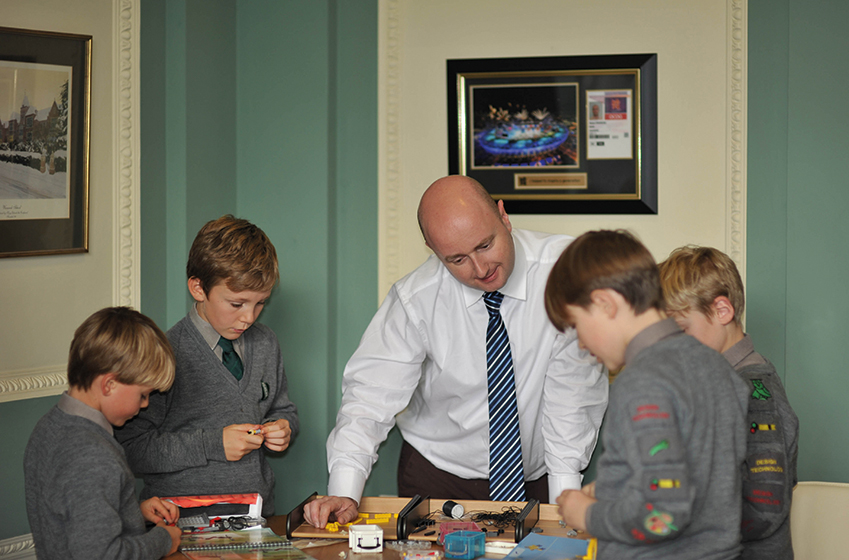The Pros and Cons of the Pre-Test
By
8 years ago
Two school heads debate the value of non-verbal reasoning tests for ten-year-olds

Heads of two top schools – one senior, the other a prep – discuss the pros and cons of the pre-test.
The pre-test: Why we love it
Jim Hawkins, headmaster of Harrow, has introduced a pre pre-test.

In September 2015, Harrow introduced a new pre-test for 13+ applicants. This examination is devised by the Independent Schools Examination Board (ISEB), which also sets Common Entrance papers. It takes the form of an online assessment consisting of multiple-choice questions in verbal reasoning, non-verbal reasoning, English and mathematics.
Boys wishing to come to Harrow in Year 9 take the ISEB Pre-Test during the autumn term of Year 6, when they are ten or 11 years old. It is a standardised, age-adaptive measure of ability and attainment, meaning that a boy who sits the test early, or who is young for his year, is not disadvantaged.
Following the pre-test, we call back good candidates in September or October of Year 7 for the Harrow Test (although the very best candidates may be fast-tracked and offered places right away). The Harrow Test comprises two important interviews (one with a house master and another with a senior beak), a computerised maths and English assessment and a short written essay. It is at this stage that we make the majority of our offers.
Getting into Harrow
When considering boys for a place at Harrow, we are not just looking for academic aptitude. Places go to those who have impressed us most in terms of ability, character, attitude and their potential to contribute and thrive here. This is why those interviews, as well as the current school’s reference, are crucial to a candidate’s success.
By filtering out unrealistic applications at pre-test stage, we can now give every good candidate the time and attention necessary for them to shine at interview. We also avoid raising false hopes (and, in some cases, large travel bills) for those lacking sufficient raw ability to cope with Harrow’s academic life. From our perspective, the pre-test allows us to keep step with the admissions schedules of our competitor schools, some of which offer places during Year 6. If we are not in the mix at the same time, we could miss out on some of the best candidates.
Criticisms of the pre-test
This new approach to admissions is flexible and adaptable. Neither the pre-test nor the Harrow Test are last-chance saloons: we keep some places aside for late-developers and for excellent late applicants, and will review a candidate who is initially unsuccessful in Year 6 if his current school tells us that the tests got it wrong or, more likely, that he simply had a bad day. Feedback from parents and feeder schools tells us that they like knowing where they stand, either with regards to planning for the Harrow Test and avoiding a hectic pre-CE rush or, in the case of our weaker applicants, looking at other schools in good time.
The most common criticisms that one hears about pre-testing are that it is too clinical, too early and too stress-inducing. On the contrary, we have already found that it is enabling us to engage more fully with the human and subjective aspects of admissions. By creating more space for dialogue and interaction, our new approach gives the most promising applicants a genuine opportunity to reveal their potential.
The Pre-Test: Why we don’t
James Hanson, headmaster of Aldro, a prep school for boys in Surrey, explains why he is not yet a fan of the pre-test.

A little boy ran past me shouting, ‘Dad, it was really easy!’ His words drifted behind him as he ran off to jump into his boat for the highly anticipated Aldro regatta. So began one conversation by the lake with a slightly concerned parent about whether their son had missed the point or should be worried about the performance on the ISEB pre-test.
For those not fully up-to-speed on the tests, each online multiple-choice test adapts to the individual user inputs. Those that race successfully through early questions will find the difficulty raised quickly, but for pupils who struggle early on, the next questions become easier. Whether this is reassuring to families hearing that the test was ‘easy’ is another matter, but we spell that out to our parents and boys when we brief them on the year ahead.
While the Common Entrance exams (mostly sat at 13) might be seen as entrance exams, they really only serve a purpose in offering common curriculum coverage. Like it or not, the major senior school decision-making process for a Year 9 start – aged 13 – takes place from the very beginning of Year 6 so, for some pupils, this means soon after their tenth birthday.
The process is made more challenging by the wide variety of assessment models for entry to these schools. Every parent wants to know how the schools make their decisions and how much influence the head’s confidential reference has? What about the interview on the assessment day? Do they have their own maths, English or reasoning assessments on a day at the school? Do they sign up for common pre-tests sat in pupils’ own schools? What about a team-building day where all candidates are assessed in a slightly alien set of scenarios? Are siblings given any help? Sadly, the answers can be as widely different for each school.
Too young to test?
As a prep school head, I’ve always asked senior schools whether they really can assess academic potential three years ahead of time with great security. What about all those late bloomers (not just the boys who we know are more likely to peak academically at 13 rather than 11), or those who had recently changed school? I was one of those slow-burners – bottom of the whole of my prep school in English and maths as a ten-year-old in Year 5. ISEB has now worked with senior schools to develop their own ‘common’ pre-test – something that prep schools have long sought to level and simplify the entry playing field. These assessments are a standardised measure of ability and attainment, run by GL assessment who also run the CAT tests that many of our schools run for their current pupils, covering English, maths, verbal and non-verbal reasoning skills.
As the majority of our senior schools take up the same framework, I am sure this will eventually lead to progress, however take-up is, as yet, quite limited, and the testing window required by each of these schools varies throughout the year. Some pupils have to sit the test in September because they are applying to one specific school, whereas their friends applying to different schools can wait until March or even into Year 7. Applications to schools can vary from ‘common’ pre-tests, to their own in-house test online, to a more traditional 11+ paper-based test to a grammar school – tests are thus anything but ‘common’. This leads me to ask again whether all schools are really assessing potential or just taking a snap-shot judgment now?
At Aldro, we desperately want our boys not to be rushed or to grow up too quickly – surely it is much better for boys just to be boys for that bit longer, and the same must be said for girls (I speak as the father of two daughters). When did den-building, rowing on the school lake, or playing conkers have to give way to hours of extra reasoning practice? Why do we feel forced to turn Year 6 (and increasingly Year 5) into a treadmill of entry test preparation, when we see so much more to education?
Suffice it to say, the young lad in question ‘passed’ his pre-test to his first choice school and was thrilled to be offered a place there. He still loves rowing on the lake, found time to do enough reasoning practice, and conker season is upon us as the trees bears fruit again.



